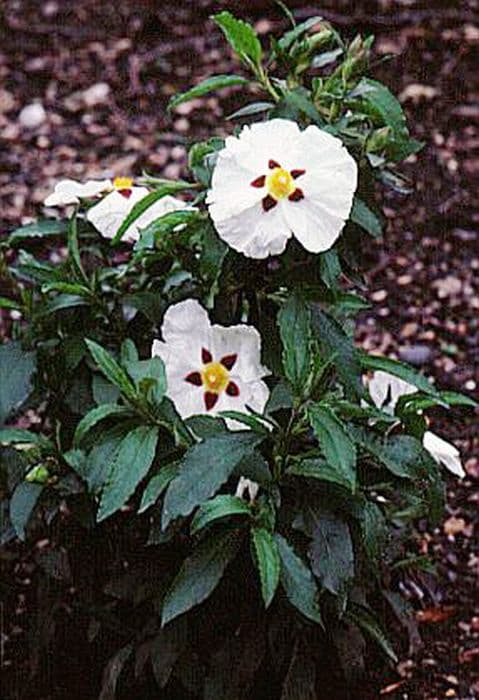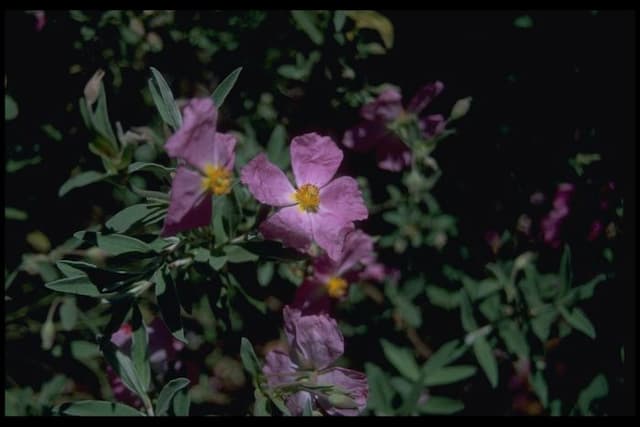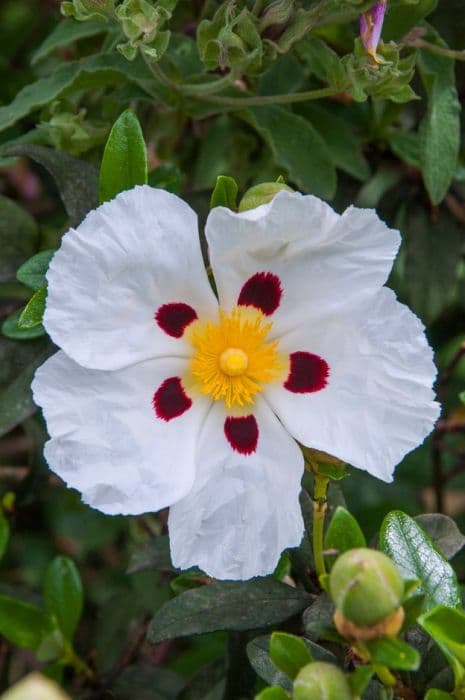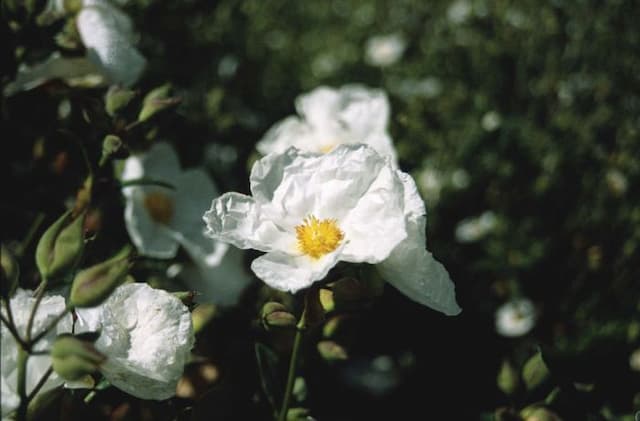Rock Rose Halimium umbellatum

ABOUT
Halimium umbellatum, commonly referred to as the shrubby rockrose, is an evergreen shrub characterized by its bushy and compact appearance. The plant displays an attractive foliage, which is typically dark green, with leaves that are small, lance-shaped, and slightly hairy, lending a soft texture to the touch. Throughout the blooming season, the shrubby rockrose bears an abundant display of flowers. The flowers are usually bright yellow with a distinct darker yellow or orange blotch at the base of each petal, offering a striking contrast against the greenery. The petals are delicate and slightly crinkled, resembling the look of tissue paper, and they form a saucer-like shape that encircles a core of numerous stamens that are often a darker shade of yellow. The overall display of the shrubby rockrose is that of a dense, floriferous shrub that enlivens the garden with its vivid yellow blossoms and persistent green foliage.
About this plant
 Names
NamesFamily
Cistaceae.
Synonyms
Sun Rose, Rock Rose.
Common names
Cistus umbellatus, Halimium atriplicifolium, Helianthemum umbellatum, Halimium atriplicifolium var. minus
 Toxicity
ToxicityTo humans
Halimium umbellatum, also known as rockrose, does not have a well-documented profile of toxicity to humans. However, it is always prudent to exercise caution and avoid ingesting plants that are not commonly used for culinary purposes or without expert knowledge of their edibility and safety. If rockrose is indeed toxic and ingested, one could potentially experience symptoms typical of plant poisoning, which may include nausea, vomiting, diarrhea, abdominal pain, and rarely more severe reactions depending on the amount consumed and individual sensitivity. It is important to consult with a medical professional or poison control center if ingestion occurs and symptoms develop.
To pets
Halimium umbellatum, commonly known as rockrose, does not appear to have a well-documented toxicity profile for pets. Nevertheless, it is generally advised to prevent pets from ingesting plants unless they are known to be safe. If the rockrose is toxic to pets, ingestion could potentially lead to symptoms similar to those seen in plant poisoning in animals, which might include vomiting, diarrhea, drooling, lethargy, or abdominal pain. If you suspect that your pet has ingested this plant and is showing signs of illness, you should contact your veterinarian or an animal poison control service promptly for advice and potential treatment.
 Characteristics
CharacteristicsLife cycle
Perennials
Foliage type
Evergreen
Color of leaves
Green
Flower color
Yellow
Height
3 feet 0.91 meters
Spread
5 feet 1.52 meters
Plant type
Shrub
Hardiness zones
7
Native area
Mediterranean
Benefits
 General Benefits
General Benefits- Landscape Aesthetics: Halimium umbellatum, commonly known as Rockrose, adds visual interest to gardens with its vibrant yellow flowers and shrubby form.
- Drought Tolerance: Rockrose is known for its ability to withstand dry conditions, making it suitable for xeriscaping and water-wise gardens.
- Erosion Control: With its woody stems and extensive root system, Rockrose can help stabilize soil and prevent erosion on slopes or in areas with loose soil.
- Wildlife Habitat: The flowers of Rockrose provide nectar for pollinators such as bees and butterflies, enhancing biodiversity.
- Low Maintenance: Rockrose is a low-maintenance plant, requiring minimal care once established, thus saving time and resources for gardeners.
- Fire Resistance: The plant is considered to be fire-resistant, which can be beneficial in fire-prone areas as part of a defensible space strategy.
 Medical Properties
Medical PropertiesThis plant is not used for medical purposes.
 Air-purifying Qualities
Air-purifying QualitiesThis plant is not specifically known for air purifying qualities.
 Other Uses
Other Uses- Dye production: Halimium umbellatum's flowers or leaves can be used to produce natural dyes for textiles.
- Insect repellent: The aromatic oils in the plant may be utilized as a natural insect repellent.
- Garden design: Due to its ornamental appeal, Halimium umbellatum is often used in xeriscaping and rock gardens for aesthetic purposes.
- Erosion control: The plant's root system helps stabilize soil and prevents erosion on slopes and banks.
- Photography subject: This plant, with its bright flowers, serves as a beautiful subject for nature photographers.
- Botanical studies: Halimium umbellatum can be used in studies of plant morphology and adaptation to arid environments.
- Floral arrangements: Fresh or dried, its flowers are sometimes used in bouquets and decorative arrangements.
- Wildlife habitat: The shrub provides shelter and nesting sites for small animals and insects.
- Privacy screens: When grown densely, it can form natural screens for privacy in gardens and parks.
- Culinary experimentation: Although not a common practice, the petals may be used as a garnish or to infuse flavor in artisanal cuisine.
Interesting Facts
 Feng Shui
Feng ShuiHalimium umbellatum is not used in Feng Shui practice.
 Zodiac Sign Compitability
Zodiac Sign CompitabilityHalimium umbellatum is not used in astrology practice.
 Plant Symbolism
Plant Symbolism- Resilience: Halimium umbellatum, commonly known as rockrose, thrives in harsh, dry Mediterranean environments, symbolizing the ability to withstand and adapt to challenging conditions.
- Beauty in aridity: With its attractive flowers that bloom in adverse conditions, rockrose represents finding and celebrating beauty even in barren or difficult circumstances.
- Purity: The bright and often white flowers of the rockrose are seen as a symbol of purity and innocence.
- Renewal: Rockrose plants can regenerate after fires, symbolizing rebirth and the opportunity for new beginnings.
 Water
WaterThe Cistus-rockrose (Halimium umbellatum) should be watered moderately; it prefers dry to medium moisture levels. As a drought-tolerant plant, it does not require frequent watering once established. During its growing season in spring and summer, water the rockrose when the top inch of soil feels dry, which may be approximately once a week, depending on climate conditions. In general, provide between 0.5 to 1 gallon of water per week, adjusting based on rainfall and temperature. During the dormant season in fall and winter, reduce watering frequency, but do not allow the soil to become completely dry for extended periods.
 Light
LightThe Cistus-rockrose thrives in full sun exposure. Plant it in a spot that receives at least six hours of direct sunlight daily. The bright light helps ensure abundant flowering and maintains the plant's compact growth habit. It should be positioned away from the shade provided by buildings, fences, or trees to maximize its light intake.
 Temperature
TemperatureThe rockrose is hardy in a range of temperatures but prefers a warm climate. It can typically withstand temperatures down to about 15 degrees Fahrenheit and is comfortable up to temperatures of 100 degrees Fahrenheit. To encourage the best growth and flowering, maintain temperatures around 70 to 80 degrees Fahrenheit.
 Pruning
PruningPruning the Cistus-rockrose is essential to maintain its shape and promote vigorous growth. Prune immediately after flowering, typically in the late spring or early summer, to remove spent blooms and any dead or overcrowded branches. An annual pruning helps encourage the next season's blooms and prevents the plant from becoming leggy.
 Cleaning
CleaningAs needed
 Soil
SoilThe rockrose (Halimium umbellatum) thrives in well-draining, sandy to loamy soil with a slightly acidic to neutral pH ranging from 5.5 to 7. A suitable soil mix can be made by combining two parts sand, one part loam, and one part peat or compost to ensure proper nutrition and drainage.
 Repotting
RepottingRockroses (Halimium umbellatum) generally require repotting every two to three years to refresh the soil and accommodate root growth. It is best to repot in spring before the onset of the growing season.
 Humidity & Misting
Humidity & MistingRockrose (Halimium umbellatum) prefers a dry to moderate humidity environment, which mimics its native Mediterranean habitat. Excessive humidity can lead to fungal issues, so it thrives in outdoor conditions with natural airflow.
 Suitable locations
Suitable locationsIndoor
Place rockrose in a sunny spot with good airflow.
Outdoor
Plant rockrose in full sun, well-drained soil.
Hardiness zone
7-10 USDA
 Life cycle
Life cycleHalimium umbellatum, also known as shrubby rockrose, begins its life cycle with seed germination, typically triggered by warm temperatures and sufficient moisture. After germination, seedlings establish a root system and develop primary leaves in the juvenile phase. The plant then enters a vegetative growth phase, where it grows stems and foliage, and with appropriate sunlight and soil conditions, it matures into a woody shrub. The adult shrubby rockrose produces vibrant yellow flowers in the spring, which are pollinated by insects, leading to the development of seed capsules. Once the seeds mature, they are dispersed into the surrounding environment, potentially establishing new plants if conditions are favorable. In the final stage of its life cycle, the plant senesces and dies, returning nutrients to the soil and making room for new growth.
 Propogation
PropogationPropogation time
Spring
Halimium umbellatum, commonly known as Shrubby Halimium, is most popularly propagated through seed sowing. The best time to sow the seeds is in the fall or early spring, when temperatures are mild and consistent, which helps with germination. Seeds should be lightly covered with soil and kept moist until germination occurs. It is often recommended to stratify the seeds before sowing, which means chilling them for several weeks in a refrigerator, at about 40 degrees Fahrenheit (4.4 degrees Celsius), to mimic winter conditions and break dormancy. It should be noted that while seed propagation is common, it does not always guarantee that the offspring will have the same characteristics as the parent plant due to genetic variability.









